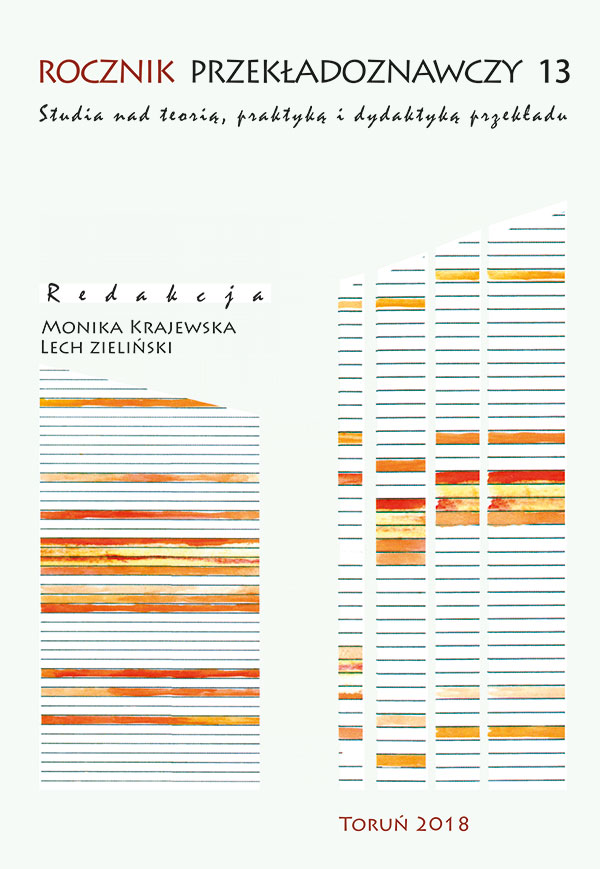Tłumaczenie ustne: jakość a skale oceny
DOI:
https://doi.org/10.12775/RP.2018.015Słowa kluczowe
tłumaczenie ustne, dydaktyka przekładu, ocenianie, kompetencja, jakośćAbstrakt
Tłumaczenie ustne jest zjawiskiem natury społecznej, które realizowane jest w określonym kontekście sytuacyjnym (i kulturowym). Kluczową rolę w komunikacji odgrywa skuteczność, której wartościowanie nie może być sprowadzone wyłącznie do oceny parametrów natury językowej. W niniejszym artykule zostaną przedstawione dwie skale, których celem jest (mierzalna) ocena tłumaczenia możliwa do wykorzystania jako narzędzie w dydaktyce przekładu ustnego, oraz skala proponowana przez autorkę artykułu, stworzona na podstawie własnego doświadczenia dydaktycznego w nauczaniu przekładu ustnego.
Bibliografia
Bühler, H., 1986, „Linguistic (semantic) and extra-linguistic (pragmatic) criteria for the evaluation of conference interpretation and interpreters”, [w:] Multilingua 5, nr 4, s. 231–235.
Colina, S., 2003, Translation Teaching: From Research to The Classroom, New York – San Francisco.
Collados Aís, A., García Becerra, O., 2015, „Quality”, [w:] The Routledge Handbook of Interpreting, H. Mikkelson, R. Jourdenais (red.), London – New York, s. 368–383.
Englund Dimitrova, B., 2002, „Training and Educating the Trainers – A Key Issue in Translators’ Training”, [w:] Teaching Translation and Interpreting 4, E. Hung (red.), Amsterdam–Philadelphia, s. 73–82.
Gile, D., 2000, „The history of research into conference interpreting: A scientometric approach”, [w:] Target, nr 12(2), s. 297–321.
Gouadec, D., 2007, Translation as a profession, Amsterdam–Philadelphia.
Kadric, M., Kaindl, K., Pöchhacker, F. (red.), 2000, Translationswissenschaft, Tübingen.
Kelly, D., 2005, A Handbook for Translator Trainers. A Guide to Reflective Practice, Manchester.
Kiraly, D., 1995, Pathways to Translation. Pedagogy and Process, Kent, Ohio.
Kiraly, D., 2000, A Social Constructivist Approach to Translator Education: Empowerment from Theory to Practice, Manchester.
Kopczyński, A., 1994, „Quality in conference interpreting: Some pragmatic problems”, [w:] Bridging the gap. Empirical Research in simultaneous interpretation, S. Lambert, B. Moser-Mercer (red.), Amsterdam–Philadelphia, s. 87–100.
Kościałkowska-Okońska, E., 2017, „Setting assessment objectives vs assessment criteria in the context of teaching specialist translation”, [w:] Translatorik, Translationsdidaktik und Fremdsprachendidaktik. Herausforderungen und Perspektiven, Frankfurt am Main – Bern – Bruxelles – New York – Oxford – Warszawa – Wien, s. 63–70.
Kurz, I., 1989, „Conference Interpreting: User Expectations”, [w:] Coming of Age: Proceedings of the 30th Annual Conference of the American Translators Association, D.L. Hammond (red.), Medford – New Jersey, s. 143–148.
Kurz, I., 1993, „Conference Interpretation: Expectations of different user groups”, [w:] The Interpreter’s Newsletter., nr 5, Universita degli Studi di Trieste, s. 13–21.
Lee, J., 2008, „Rating Scales for Interpreting Performance”, [w:] The Interpreter and Translator Trainer, nr 2(2), s. 165–184.
Marrone, S., 1993, „Quality: A Shared Objective”, [w:] The Interpreter’s Newsletter, nr 5, s. 35–41.
Mesa, A.-M., 2000, „The Cultural Interpreter: An Appreciated Professional. Results of a Study on Interpreting Services: Client, Health Care Worker and Interpreter Points of View”, [w:] The Critical Link 2: Interpreters in the Community, R. Roberts, S.E. Carr (red.), Amsterdam–Philadephia, s. 67–79.
Moser, P., 1995, „Simultanes Konferenzdolmetschen. Anforderungen und Erwartungen der Benutzer. Endbericht, im Auftrag von AIIC”, [w:] SRZ Stadtund Regionalforschung: Wien.
Moser-Mercer, B., 2000, „Simultaneous interpreting: cognitive potential and limitations”, [w:] Interpreting, nr 5(2), s. 83–94.
Moser-Mercer, B., 2007, „Global cognition: Training a new breed of interpreter trainers”, [w:] Interpreting studies and beyond, F. Pöchhacker, A. Lykke Jakobsen, I.M. Mees (red.), Copenhagen, s. 89–101.
Moser-Mercer, B., 2008, „Skill acquisition in interpreting”, [w:] The interpreter and translator trainer, nr 2(1), s. 1–28.
Pöchhacker, F., 2000, „The Community Interpreter’s Task: Self-Perception and Provider Views”, [w:] The Critical Link 2: Interpreters in the Community, R. Roberts, S.E. Carr (red.), Amsterdam–Philadephia, s. 49–65.
Pöchhacker, F., 2001, „Quality Assessment in Conference and Community Interpreting”, [w:] Meta, nr 46(2), s. 410–425.
Pöchhacker, F., 2004, Introducing interpreting studies, London – New York.
Pöchhacker, F., 2013, „Researching quality: a two-pronged approach”, [w:] Quality in interpreting: Widening the scope, t. 1, O. García Becerra, E. Macarena Pradas Macías, R. Barranco-Droege (red.), Granada, s. 33–56.
Riccardi, A., 2002, „Evaluation in Interpretation: Macrocriteria and Microcriteria”, [w:] Teaching Translation and Interpreting 4. Building Bridges, E. Hung (red.), Amsterdam–Philadephia, s. 115–126.
Sawyer, D., 2004, Fundamental Aspects of Interpreter Education: Curriculum and Assessment, Amsterdam–Philadelphia.
Tryuk, M., 2012, „Ocena jakości w tłumaczeniu ustnym. Konieczny etap kształcenia tłumaczy konferencyjnych”, [w:] Lingwistyka Stosowana, nr 6, s. 45–55.
Viezzi, M., 1996, Aspetti della Qualita in Interpretazione, Trieste: SSLMIT.
Pobrania
Opublikowane
Numer
Dział
Statystyki
Liczba wyświetleń i pobrań: 417
Liczba cytowań: 0



